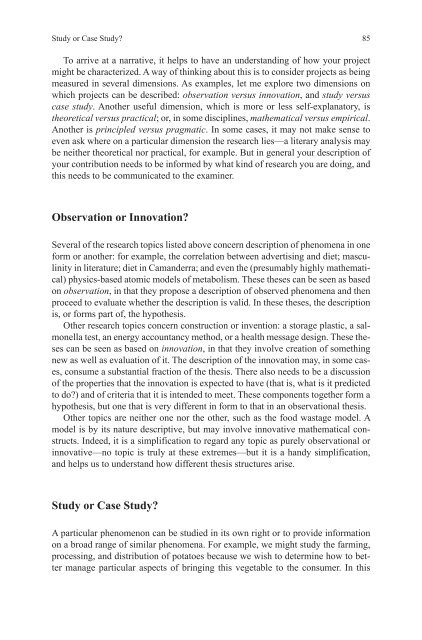How-to-Write-a-Better-Thesis
You also want an ePaper? Increase the reach of your titles
YUMPU automatically turns print PDFs into web optimized ePapers that Google loves.
Study or Case Study? <br />
85<br />
To arrive at a narrative, it helps <strong>to</strong> have an understanding of how your project<br />
might be characterized. A way of thinking about this is <strong>to</strong> consider projects as being<br />
measured in several dimensions. As examples, let me explore two dimensions on<br />
which projects can be described: observation versus innovation, and study versus<br />
case study. Another useful dimension, which is more or less self-explana<strong>to</strong>ry, is<br />
theoretical versus practical; or, in some disciplines, mathematical versus empirical.<br />
Another is principled versus pragmatic. In some cases, it may not make sense <strong>to</strong><br />
even ask where on a particular dimension the research lies—a literary analysis may<br />
be neither theoretical nor practical, for example. But in general your description of<br />
your contribution needs <strong>to</strong> be informed by what kind of research you are doing, and<br />
this needs <strong>to</strong> be communicated <strong>to</strong> the examiner.<br />
Observation or Innovation?<br />
Several of the research <strong>to</strong>pics listed above concern description of phenomena in one<br />
form or another: for example, the correlation between advertising and diet; masculinity<br />
in literature; diet in Camanderra; and even the (presumably highly mathematical)<br />
physics-based a<strong>to</strong>mic models of metabolism. These theses can be seen as based<br />
on observation, in that they propose a description of observed phenomena and then<br />
proceed <strong>to</strong> evaluate whether the description is valid. In these theses, the description<br />
is, or forms part of, the hypothesis.<br />
Other research <strong>to</strong>pics concern construction or invention: a s<strong>to</strong>rage plastic, a salmonella<br />
test, an energy accountancy method, or a health message design. These theses<br />
can be seen as based on innovation, in that they involve creation of something<br />
new as well as evaluation of it. The description of the innovation may, in some cases,<br />
consume a substantial fraction of the thesis. There also needs <strong>to</strong> be a discussion<br />
of the properties that the innovation is expected <strong>to</strong> have (that is, what is it predicted<br />
<strong>to</strong> do?) and of criteria that it is intended <strong>to</strong> meet. These components <strong>to</strong>gether form a<br />
hypothesis, but one that is very different in form <strong>to</strong> that in an observational thesis.<br />
Other <strong>to</strong>pics are neither one nor the other, such as the food wastage model. A<br />
model is by its nature descriptive, but may involve innovative mathematical constructs.<br />
Indeed, it is a simplification <strong>to</strong> regard any <strong>to</strong>pic as purely observational or<br />
innovative—no <strong>to</strong>pic is truly at these extremes—but it is a handy simplification,<br />
and helps us <strong>to</strong> understand how different thesis structures arise.<br />
Study or Case Study?<br />
A particular phenomenon can be studied in its own right or <strong>to</strong> provide information<br />
on a broad range of similar phenomena. For example, we might study the farming,<br />
processing, and distribution of pota<strong>to</strong>es because we wish <strong>to</strong> determine how <strong>to</strong> better<br />
manage particular aspects of bringing this vegetable <strong>to</strong> the consumer. In this














![[Lonely Planet] Sri Lanka](https://img.yumpu.com/59845622/1/169x260/lonely-planet-sri-lanka.jpg?quality=85)


